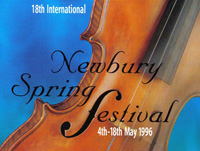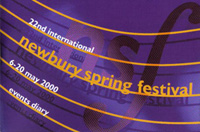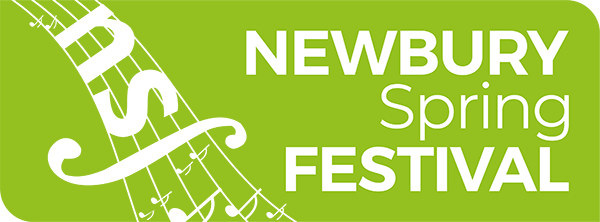“I have very happy memories of performances at Newbury Festival going back to my student days – concerts with some of my dearest friends and colleagues.”
History of Newbury Spring Festival
On May 10 1979 the Newbury Weekly News heralded Berkshire’s ‘most artistic venture to be launched for a decade’ and four weeks later celebrated ‘the resounding success of the 10-day extravaganza of music, art, poetry and drama’ that was ‘Spring Festival fantastic’.

This vision of an arts festival for the town had taken root the previous year with a gala concert in the old Corn Exchange which Jeanie, Countess of Carnarvon, then Lady Porchester, had invited John Wright to organise as a fundraiser for the newly-refurbished Arts Workshop of which she was president.
It was, by all accounts, a wonderful event headed by two musicians fresh from the Menuhin School: an outstanding young violinist from the Juilliard called Nigel Kennedy and pianist Yitkin Seow.
They performed in the presence of HRH The Duchess of Kent, who was to become the festival’s loyal patron, launching a nine-day showcase of community art, craft, music, poetry and drama which set up Newbury’s new arts centre for 20 years’ creative activity.

Experience of other festivals led John Wright to spot Newbury’s potential for a festival, with its perfect catchment between London, Bath, Oxford and Winchester, fine tradition of choral music and a history of performances by renowned musicians such as Henry Wood at the Corn Exchange. But the festival movement was in its early stages with only a few being organised across the country and, says Lady Carnarvon, “Newbury was still a farming community, not today’s centre of high-tech. It would be so easy to under-rate the boldness of the idea at that time.”
Three weeks later, as John’s ideas and costings for a week-long festival were discussed over lunch at Milford Lake House, Lord Carnarvon left the table, returning with a discrete note – his personal recommendation of the 10 people who would later form the festival committee, most of whom maintained a life-long commitment.” Lady Carnarvon chaired that committee for 18 years before she became the festival’s president and handed the reins to Sandra Edwards, who was followed by the current chairman David Livermore.

“In the early days, trying to find support, then getting supporters to find supporters was an uphill struggle,” she remembers, with tremendous admiration for John’s drive in the face of sceptics. “He was incredibly brave, going and seeing people, asking for help to get things off the ground. More than a few said you can’t possibly do this.”
But an early breakthrough in the daunting task of raising money came through John’s previous connection with a festival in the Lake District. The English Tourist Board was first to back what it agreed was “an ideal location” by putting up £500 a year for three years towards publicity.
Armed with that promise, Lady Carnarvon supported John Wright in presenting their case to a meeting of some 40 Newbury district councillors. As John recalls: “They sat so stoney-faced, we came away from the meeting wondering whether we’d been taken notice of at all. But at eight the following morning the chief executive rang to tell me that the council was very much on our side and wished to make a grant offer of £2,000. This, with the ETB money, meant we could go ahead and invite commercial sponsorship.” From this firm base, the festival has continued to be remarkably successful in attracting funding from the business sector, reducing its reliance on grant aid and so gaining freedom to determine its own programme.
And so they arrived at the long anticipated opening concert at St. Nicolas’ Church – the London Mozart Players conducted by Harry Blech. “Marvellous,” says John, but “nerve racking” according to Lady Carnarvon, the conductor was late in arriving and the audience were already seated when Blech strolled down the aisle, baton in hand, to mount the rostrum.
At that time she’d had little experience of classical music but with over 30 festivals now behind her Lady Carnarvon is resigned to the fact that it will always be “tense in the run-up to every festival.”

Hosting the cream of the music world also introduced her to the artistic temperament, and she has fond memories of the cello maestro Paul Tortelier who, when staying at Milford Lake House, would walk with her “for miles”. Once, after resting all afternoon and “horrified to learn my husband wasn’t coming to his Festival recital, he suddenly appeared in his dressing gown and made us all sit down to listen to him play some Bach. He’d written a composition about a horse for Prince Charles but didn’t feel he knew enough about horses and needed the Earl’s opinion as to whether it gave the feeling of a horse in full flight!”
It was some years before they were confident that the Festival was on-going and Devina Cameron was appointed as the first of five paid administrators (Devina is still very much involved in the Festival today). John moved from Surrey to work from his new Kintbury home and everything else was dependent on volunteers, says Devina “Muriel Storey ran the box office from the Granary and her knowledge of local people was absolutely tremendous. She knew every single Friend, by name”, a personal touch which nurtured the loyalty of many supporters.
The Festival had soon developed a character of its own – the late Peter Davies’ review of the Aeolian String Quartet’s Schubert recital in the inaugural year was prefaced with ‘forget the hard pews the music was fine’ and it wasn’t long before the queues snaking into the church, with cushions tucked firmly underarm became a tradition. Lady Carnarvon puts her hand up to that one: “Down to my family, I’m afraid …so many complaints about hard pews! I urged people not to be shy of bringing cushions. We even looked into hiring them, but the cost was just too high.” This explains the theory behind 2008’s special anniversary cushions, a fundraising objective in celebration of 30 years of the Newbury Spring Festival.
Confirmation that the festival was held in high esteem by leading musicians, too, came after Kurt Masur’s Festival appearance with the philharmonic. At a reception following Mendelsohn’s ‘Elijah’ in St Paul’s Cathedral, the renowned conductor left his party to clap John’s shoulder, extolling the virtues of Newbury’s: “wonderful church with the fine acoustic”.
The previous, annual London launches, first on the Martini Terrace at New Zealand House, then at The Savile Club in Brook Street, helped to establish the Festival’s reputation with the music media, when opened by such worthy figures in the arts world as former Arts Council chairman Lord Palumbo and Jeremy Isaacs from the Royal Opera House. The Festival was lucky enough to have influential guest speakers each year; 2009’s guest speaker, David Whelton, Director of the philharmonic Orchestra, referred to the Newbury Spring Festival as “one of the best music festivals in the UK”.

Momentum gathered as great orchestras, chamber musicians and soloists were attracted to Newbury – the LSO, the philharmonic, the Halle, the Academy of Ancient Music, BBC Philharmonic, Murray Perahia, John Lill, Yehudi Menuhin, to name just a few – and by 1985 the Newbury Spring Festival was already being acknowledged as one of the Top 20 arts festivals in the country. As it grew in stature the programme extended from 10 to 14 days, reaching out from its main venue of St Nicolas’ Church and into the local villages, widening the Festival’s appeal.
In 1999, 20-years after founding the Festival, and having built a festival of international status with a sound financial and artistic base, John Wright felt it was a good time to hand over to a new generation to take it into the new millennium. The committee was aware that the Festival couldn’t stand still; it had to grow, so with a view to future development they appointed Mark Eynon as the new artistic director.
For Mark Eynon, the festival’s reputation for quality was one of its main attractions. “Festivals are about the places they happen and they are all very different,” but in Newbury “I was reminded of happy days directing the Henley and Salisbury Festivals which I left sooner than intended when invited to work at the Opera House. Here was the opportunity to get back to where I left off with an established festival.”
He enjoys working along themes as a loose focus for ideas and over the past years he has done everything possible to shake off the ‘elitist’ tag often attached to classical music. A key part of the Festival is integrating local amateur groups into the programme such as the Newbury Symphony Orchestra, further developing the Young Artists Lunchtime Recital series programme and involving Berkshire Maestros in the Masterclass series. Mark has devoted a considerable amount of time broadening the range of music to encompass more world music, dance and comedy and establishing a ‘lighter side’ to Festival at the Corn Exchange. But to him “quality will always come first”.
In particular, Mark relishes the challenge of developing young audiences and increasing community involvement, the most notable being the creation of the Spring Festival Chorus which during their 10th anniversary joined the City of London Sinfonia in opening the 2009 Festival. The Festival is extremely proud of the wide area it covers; from Lambourn in the West to Theale in the East, and the variety of beautiful churches and private houses that are visited.

Over the past five years, highlights have included the Soweto Gospel Choir at Douai Abbey which has become one of the Festival’s major venues and established a tradition of world class choirs. Also in 2006, the Victoria Mullova Ensemble performed an unforgettable concert at Englefield House. In 2008 John Williams and Emanuel Ax both performed in the Corn Exchange, developing a pattern of an International Celebrity Recital Series in this venue. In 2004 the Tibetan Monks from Tashi Lhunpo Monastry took part in an exciting week long Festival residency.
Today a third of the Festival’s income is derived from ticket sales, another third from charitable trusts with the remainder being made up of corporate sponsorship, individual donations, fundraising events and Friends subscriptions. The Friends of the Newbury Spring Festival continues to go from strength to strength, and the revenue provides essential core funding for the running costs of the Festival.
Time and time again you hear of the strength of support enjoyed by Newbury Spring Festival. For Lady Carnarvon “It’s been rewarding to see the number of people who wouldn’t have dreamt of going to classical music, suddenly there and coming back every year, for over 30 years. People come back and bring new people, and you meet up with friends you may not have seen all year.”
Browse previous years

Search back through the last 10 years in our Festival Archive:
